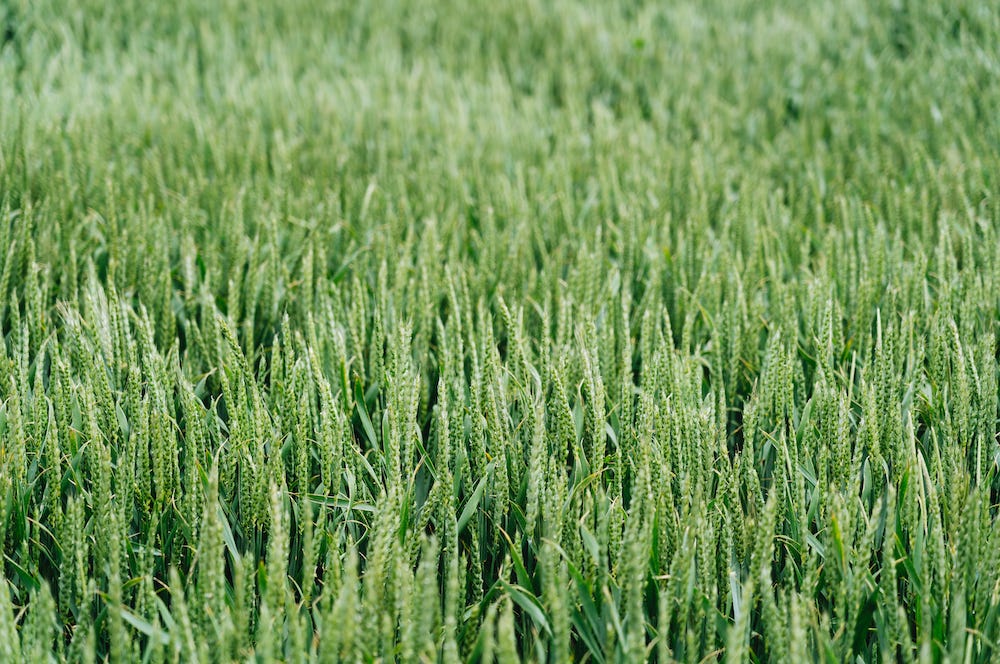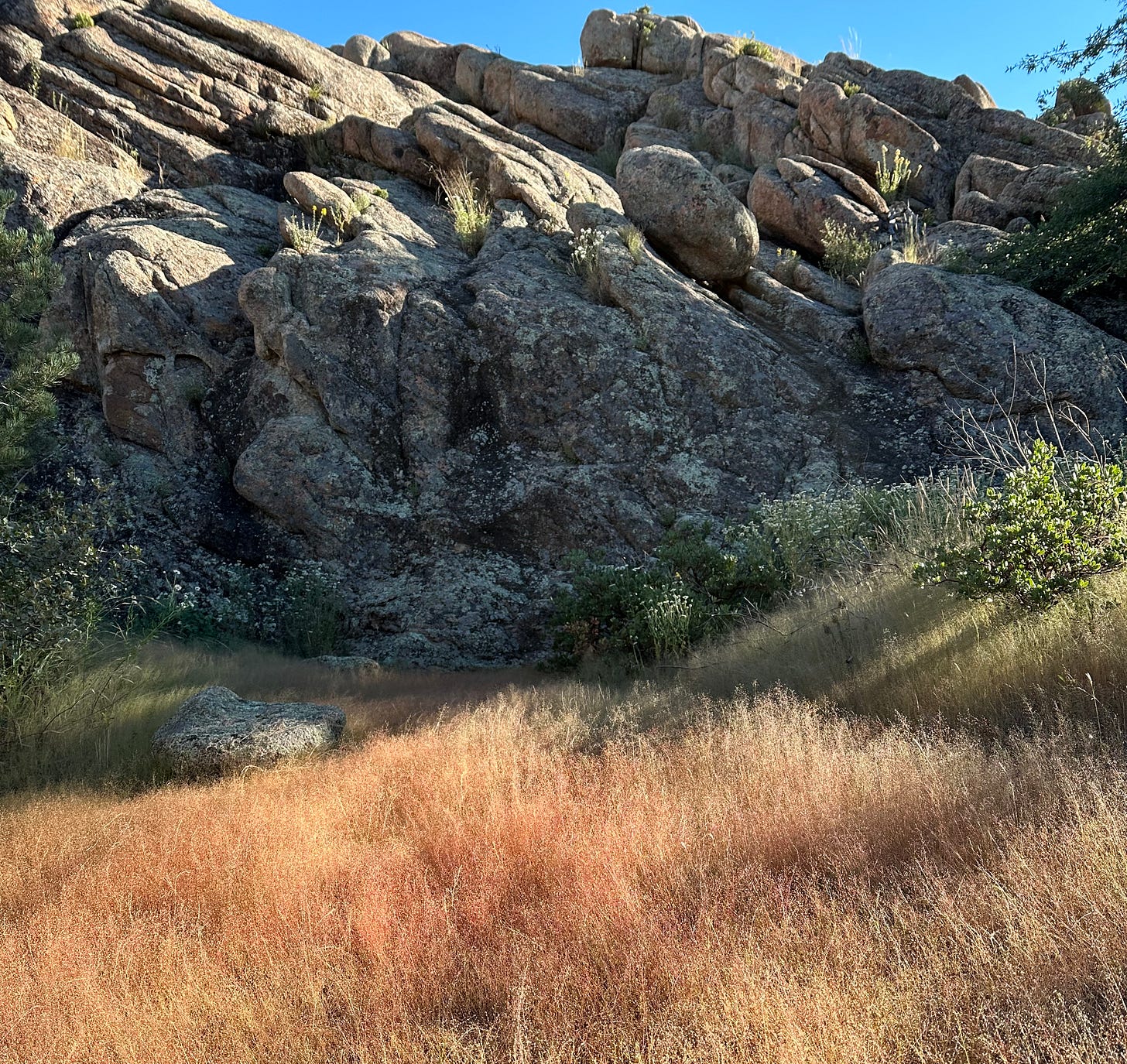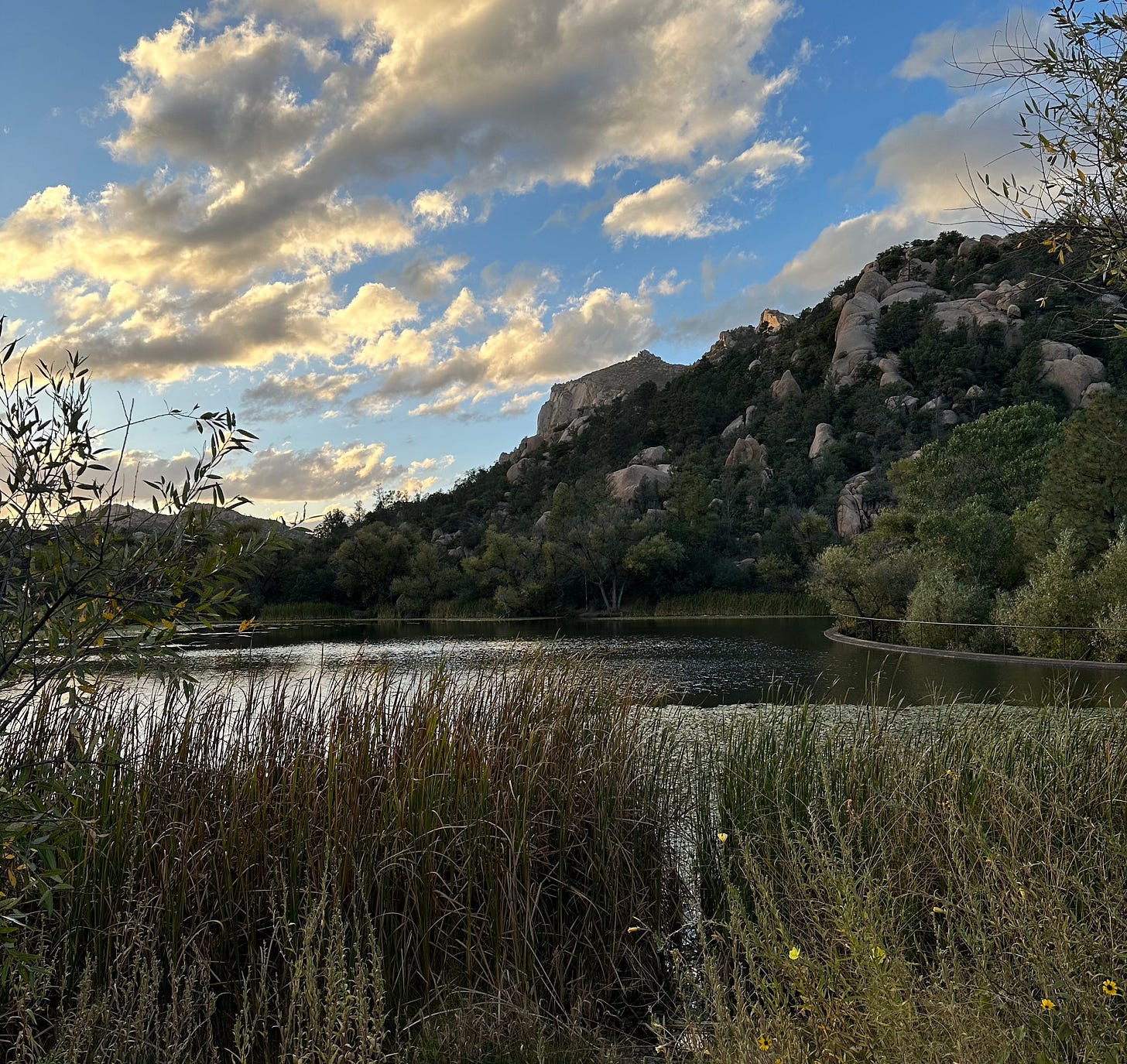On Origin Stories
Bedtime stories, Genesis, and Braiding Sweetgrass
I wasn’t raised religious. But there was a small window of time in my early years when my parents, who both grew up Catholic, sought to impart some Christian values by reading to me from a children’s Bible. I knew somehow these stories had a status that set them apart from all my other beloved picture books. There was a stifling shift, a stiffening in the atmosphere when Dad pulled out the Children’s Garden of Virtues, and I knew he was not going to be doing any funny voices.
I didn’t know until many years later that it was me who put an early stop to these religious readings. The episode which was the last straw for my dad is only a vague half-memory for me, which didn’t come back until he discussed it with me in my teenage years.
One night when I was only five or six, Dad was reading me a story from my children’s Bible. I believe it was an adaptation of Job or some such tale where God takes absolutely everything from a virtuous, pious person just to see whether or not they lose their faith. I simply could not believe that GOD, the being who is supposed to love us most, would do something so boundlessly cruel and frankly petty – it’s abusive, this need to test someone’s loyalty and judge them by their actions at their most extreme limits. This story felt less plausible than all my storybooks of frogs and toads being friends, of families of bears going on vacation, of mice who want cookies, of green eggs and ham. It offended me that such an outrageous tale was taken so much more seriously, as some kind of greater truth, than stories from my other books. So – with all my five-year-old boldness and no awareness whatsoever of the many centuries of wars fought and lives taken in the name of the Abrahamic religions – I interrupted the story with the greatest blasphemy of all.
“Dad,” I said, “that didn’t happen.”
Of all the wonderful things my father has done for me, one of the greatest has to be his choice to affirm me in that moment. He told me I was right, he closed the book, and that was the end of my religious home education. Clearly, his heart wasn’t in it either – we both had more fun when he was pretending to be the Big Bad Wolf anyways.
Once I went off to school, I was labeled as “gifted” and always got the best grades and test scores, but I felt this was primarily due to my innate, even pathological desire to please adults and an unflappable capacity for following directions. I didn’t feel I was someone with particularly strong opinions, who questioned received ideas, or who was quick-witted in arguments. American public education does not exactly provide many spaces that reward original or nuanced thinking. At my school, there wasn’t even a debate team or a model UN – I was captain of the quiz bowl team, where I earned prizes for memorizing vast amounts of information and recalling them on demand.
But learning this story from my dad shifted my self-perception dramatically. My whole life, I apparently have had a strong sense of what I believe and what I don’t, of what feels true and what feels like bullshit, and I wasn’t afraid to point it out at five. I couldn’t hold my tongue and play along when something so clearly wasn’t right to me. It wasn’t something innately lacking within me, but the way I was socialized as a precocious girl, that led me to fall in line and blindly accept what I was told in school, about myself and about the world, for many years.
This knowledge comes as a great relief to me. This myth of myself, which I both remember and don’t remember, has become a key origin story for me, a greatly empowering one. I’ve come to identify with it more than all the narratives of my academic aptitude which defined my self-conception for so much of my life. I hope that this innate boldness, conviction, and sense of justice foreshadow the kind of thinker and writer that I am striving to become every day.
What took me back to my short-lived Bible readings recently, and more broadly to the concept of origin stories, was a new origin story I was introduced to in Braiding Sweetgrass: Indigenous Wisdom, Scientific Knowledge, and the Teaching of Plants. This book, by decorated botany professor and Potawatomi Nation member Robin Wall Kimmerer, is a sacred text for me if I’ve ever found one. Its wisdom and truth strike me immediately and intuitively, just as my Children’s Bibles’ falsity did all those years ago. Braiding Sweetgrass is one of those exceedingly rare books like All About Love by bell hooks which is down-to-earth yet full of radically transformative ideas, all of which can be put into practice in our daily lives. Moreover, it has arrived in my life at the perfect moment, when my new job and newfound home in Arizona have turned my attention outwards to nature like never before. As such, it’s a book that I feel I’ll never stop reading now that I’ve started.
Before I pass along the Anishinaabe origin story which Kimmerer relates in the chapter “In the Footsteps of Nanabozho: Becoming Indigenous to Place,” let’s remind ourselves of the specifics of an origin story you undoubtedly know already – the opening verses of Genesis, when God creates the world in seven days. He first creates light, separates the world into land and water, covers the land in plants, populates the sky with birds and the water with fish, and fills the land with terrestrial animals. Lastly, he makes mankind in his own image, to rule over all the other life forms.
“Then God said, “Let us make man in our image, after our likeness. And let them have dominion over the fish of the sea and over the birds of the heavens and over the livestock and over all the earth and over every creeping thing that creeps on the earth.” (Genesis 1:26, ESV)
This idiosyncratic phrasing means, in a nutshell, everything came to be in the world virtually all at once — from the bottom of the hierarchy to the top, with man at the top and closest to God, endowed with the command over the world’s resources, instructed to be fruitful and multiply.
The Anishinaabe peoples of the Great Lakes region have their own myths of the creation of the Earth and of the Original Man, but these are two separate stories with a very long gap of time between them. In Anishinaabe myth, the first human Nanabozho came into being not in a world that was newly created to perfectly suit all his needs, but in a world already full of plant and animal life that had existed for eons before him. As the first human, Nanabozho of course had no idea how to survive, but luckily, he was surrounded by teachers who had accumulated great wisdom over countless generations living on Earth – the plants and animals!
“His role was not to control or change the world as a human, but to learn from the world how to be human.” (Braiding Sweetgrass, 208)
Nanabozho learned the names of his fellow creatures so he could greet them respectfully and ask them to share their gifts and knowledge. For example,
“When he needed food, he noticed what the animals were eating and copied them. Heron taught him to gather wild rice. One night by the creek he saw a little ring-tailed animal carefully washing his food with delicate hands. He thought, “Ahh, I am supposed to put only clean food in my body.” (210)
Through the intimacy he built with the rest of creation based on close observation and reverence, Nanabozho learned all that he needed to know to survive and thrive in this world.
I find many things remarkable about this story of Nanabozho as compared to the story of Genesis. It’s far more compatible with what science can tell us about the origin and evolution of species than the Christian creation myth – we know through carbon-dating of fossils that plants, animals, and fungi existed for millions and sometimes more than a billion years before the first humans. Everything was not created at once. Like Nanabozho, humans were and still are the newcomers to life on Earth, the youngest siblings of creation. It makes no sense for us latecomers to barge in with guns blazing, telling the rest of creation how to exist to best serve our needs – the sensible thing to do is to observe how the existing, long-enduring harmony works and find how we can fit ourselves into it.
These two origin stories set up two different visions of man’s relationship to nature, which have clearly played out in the societies built upon them. The United States was founded by fundamentalist Christian refugees, let us not forget, who displaced and decimated indigenous populations, disregarding their long-built bodies of knowledge and careful stewardship of this land in favor of a frantic free-for-all grab for resources. This is undoubtedly connected to the settlers’ belief in man’s purpose set out in Genesis – that all of creation is at our disposal and here for our exclusive benefit, and that we don’t need to listen to the land because our knowledge comes from God. This extractive capitalist ethic has destroyed ancient landscapes and ecosystems, driven countless species to extinction, and is actively creating an unlivable climate and rampant natural disasters, not only here in the US, but across the entire world.
Taking stock of where we’ve ended up in light of the story of Genesis, we may be led to think that humans are a fundamentally destructive factor in this world, that our impact on the rest of nature always involves taking resources for ourselves which could benefit others. But Kimmerer disagrees – humans are not destined to harm nature. This proposition makes no sense because we are a part of nature, we arose out of nature, and we have evolved mutualistic relationships with other life forms like any other species.
Kimmerer encourages us to think about what a different place this country could have been, and perhaps still could be, if we thought of ourselves as students of the land, like Nanabozho, instead of owners of the land. Just as teaching enriches both students and teachers, we can make use of the powers of plants and animals while also taking care of them and ensuring their continued flourishing, through the principle of reciprocity.
This reciprocal framework can counter our panic in face of the hard sacrifices we will have to make to reverse climate change, which keep many people stuck in terrified inaction. Because we have sacrificed nature to our own needs, we fear that a rebound is necessary which will require us to sacrifice ourselves to nature’s needs. But Kimmerer asks, what sacrifices? It is a privilege to give back to the Earth that has given us life. There is no black-and-white struggle of man versus nature. Obviously, healing the earth will demand enormous amounts of our labor, but Kimmerer asserts that this labor will heal us in turn. It is still possible for humanity to return to its organic relationship to the land, one which ensured mutual flourishing.
The capitalist idea that life is a zero-sum game, and that all the benefits we derive must come at the price of some other humans’ or species’ loss, is a bias built into even our most supposedly objective systems. Kimmerer and one of her graduate students found exactly the opposite to be true when conducting a study on sweetgrass, a plant sacred to the Potawatomi people, whose legends say it was the very first to grow in their ancestral land in the Great Lakes region. Kimmerer’s student Laurie was fascinated by the sacred role of this plant in many indigenous cultures. Through conversations with tribal elders, she found that some groups harvest the grass by cutting it, while others pull up the whole plant, roots and all. Both types of harvesters insist that their method is best for the health of the grass plot. So Laurie decided for her thesis project to test which harvesting method led to better outcomes for a patch of sweetgrass, with no harvesting as her control.
The faculty committee tasked with hearing and approving this project proposal was not impressed with this melding of traditional knowledge and science. This was not a question that interested them – “Anyone knows that harvesting a plant will damage the population,” one male professor quipped. “You’re wasting your time. And I’m afraid I don’t find this whole traditional knowledge thing very convincing.”
But thankfully, with Dr. Kimmerer on her side and confident in the value of this research, Laurie was able to push through with the project anyways. After two years of painstaking observation, of literally watching grass grow, she found something that confounded scientific expectations – both harvesting methods led to better outcomes for the grass than no harvesting at all. It seems that sweetgrass has evolved to benefit from being harvested by humans and suffer when it is left to its own devices. And so the scientist who deemed it obvious that anything taken for our own use must be a loss to nature was completely wrong – sweetgrass thrives and grows faster when we use it in a sustainable manner (a measured amount of it, never more than half a patch) instead of leaving it alone.
On the other hand, Lena, one of the tribal elders consulted for the experiment, accurately predicted the results based on wisdom passed down to her from her grandmother – “If we use a plant respectfully, it will stay with us and flourish. If we ignore it, it will go away. If you don’t give it respect it will leave us.” Who can still find this “traditional knowledge thing” unconvincing?
These are just a couple of the many stories that make Braiding Sweetgrass such a hopeful, essential text for this moment. Although the damage American society has done to the planet is enormous and terrifying, it has clearly happened because the people on this land have lost touch with the indigenous knowledge that once guided our relationship with it. But this knowledge, despite the U.S.’s government best efforts to eradicate it through genocidal practices against indigenous people, is far from all lost. It is essential to our survival as species to take our cues from the indigenous communities that persist in this occupied land. When Kimmerer calls us to “become indigenous to place,” this does not mean literally joining tribes and appropriating indigenous culture as our own. Becoming indigenous to the places we live in means learning to treat them as sacred communities of beings who all deserve to thrive as much as we do, far into the future, just as they have thrived long before we came here. It means letting indigenous land stewardship be the model and guiding principle as we necessarily dismantle and remake our relationship to nature. It means creating as much space as possible for indigenous people with the deepest rooted teachings — which Kimmerer beautifully describes as “old-growth knowledge” — to lead these efforts.
Faced with the choice between the story of Genesis and the story of Nanabozho as an origin, I know which one sets up the world as a place I can feel at home in. “Student” has always been the identity I fit most naturally into, my chosen inclination to the world. Thinking of nature as my teacher, not as my dominion, makes me feel that I can call this loving planet home in the most profound sense, and push forward with this never-ending joyful task of learning to be a human interconnected with all of creation.






Fantastic post.
Love love love this post thank you for sharing!! The way Christian theology has negatively shaped the US relationship with nature is so interesting/important to discuss. Definitely going to be picking up a copy of braiding sweetgrass soon!